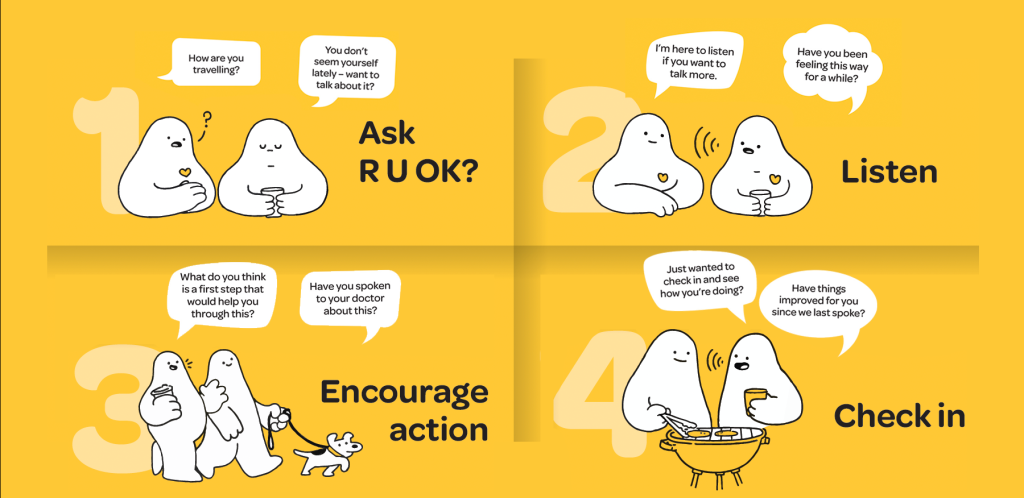We’ve all been there—someone asks, “Are you okay?” and it feels a bit too routine, doesn’t it? In our fast-paced world, authentic connections matter more than ever. Instead of sticking to the usual script, why not explore some thoughtful alternatives that can foster deeper conversations? In this post, we’ll dive into the significance of emotional check-ins and offer creative ways to engage meaningfully with those around you.
Understanding the Importance of Emotional Check-Ins

Emotional check-ins are crucial for maintaining healthy relationships. They go beyond surface-level inquiries and invite vulnerability and openness. Here’s why they matter:
- Builds Trust: When you take the time to ask more meaningful questions, it shows that you genuinely care. This fosters a safe space for others to express themselves.
- Encourages Vulnerability: By moving past the generic “Are you okay?” you invite others to share their true feelings. It encourages a culture of honesty and support.
- Enhances Connection: Deep conversations strengthen bonds. When people feel heard and understood, it creates a sense of belonging.
Let’s break down some different ways you might approach emotional check-ins:
1. Use Specific Questions
Instead of asking a broad question, try something more specific. For instance:
- “What’s been on your mind lately?”
- “How are you feeling about that project you’re working on?”
- “What’s been the highlight of your week so far?”
These questions prompt more thoughtful responses and demonstrate your interest in their experiences.
2. Share Your Own Feelings
Sometimes, leading by example can encourage others to open up. You might say:
“I’ve been feeling a bit overwhelmed with work lately. How about you?”
This approach not only normalizes sharing feelings but also invites reciprocal honesty.
3. Check-In Nonverbally
Not every emotional check-in needs to be verbal. Small gestures can go a long way:
- A reassuring pat on the back
- A warm smile during a tough moment
- Offering a listening ear without interrupting
These nonverbal cues can communicate your support without saying a word.
4. Create Rituals for Emotional Check-Ins
Establishing regular check-in moments can nurture deeper connections. For example:
- Weekly coffee chats with friends or family
- Monthly team meetings dedicated to sharing personal highs and lows
- Daily “how was your day?” texts or calls
These rituals create a framework for ongoing support and connection.
In conclusion, emotional check-ins are vital for nurturing relationships. By shifting from the standard “Are you okay?” to more thoughtful alternatives, we can foster deeper understanding and connection. So, let’s make our conversations more meaningful and show those around us that we truly care.
Also Read This: Why OK.ru Is Paving the Way for the Future of Social Networking in Russia
3. When to Use Alternative Phrases
Knowing when to swap out "Are you okay?" for something more thoughtful can make a world of difference in your conversations. It’s all about reading the room and being attuned to the emotional context. Here are a few scenarios where alternative phrases shine:
- During Tough Times: If a friend has recently experienced a loss or significant change, a simple "Are you okay?" might feel too generic. Instead, try asking, "How are you holding up through this?" This shows you recognize their struggle and are ready to listen.
- In a Moment of Silence: If someone seems lost in thought or withdrawn, they might not respond well to a direct question about their well-being. Try saying, "I’m here if you need to talk," which opens the door without pressure.
- After a Disagreement: Following a conflict, asking "Are you okay?" may come off as insincere. Instead, consider saying, "I care about how you feel. Can we talk it through?" This frames the conversation in a constructive manner.
Pay attention to non-verbal cues, too. If someone’s body language suggests discomfort or sadness, it's your cue to approach the topic with sensitivity. This might mean using a softer tone or choosing your words with care. Remember, the goal is to foster connection and understanding, not simply check a box on a conversation checklist.
Also Read This: Why OK.ru Is a Powerful Tool for Discovering and Participating in Local Events
4. Thoughtful Alternatives to Are You Okay
Now that we’ve established when to use alternative phrases, let’s dive into some thoughtful options that you can incorporate into your conversations. These alternatives can help you connect on a deeper level while showing genuine concern:
- “How have you been feeling lately?” – This open-ended question invites them to share their emotions without feeling cornered.
- “What’s been on your mind?” – This phrase gives the person the opportunity to express any concerns or thoughts they may have.
- “I noticed you seem a bit off today; want to talk about it?” – This shows you’re observant and genuinely care about their state of mind.
- “I’m here for you if you want to chat or vent.” – By offering your support, you create a safe space for them to open up.
- “Is there anything you need right now?” – Sometimes, people may not want to talk but might appreciate a practical offer of help.
It’s essential to tailor your approach based on your relationship with the person. Close friends may appreciate more direct inquiries, while acquaintances might respond better to a gentler touch. The key is to communicate with empathy and patience.
Remember, the goal is to foster a supportive space, not to probe for information. Listening attentively and responding with care can turn a simple conversation into a meaningful exchange, strengthening your connections and showing those around you that you genuinely care.
Also Read This: A Beginner’s Guide to Creating Your First Account on OK.ru
5. Tips for Choosing the Right Phrase
When it comes to checking in on someone, the phrasing you choose can set the tone for the entire conversation. Instead of the classic “Are you okay?” which may come off as generic or even dismissive, consider these tips to select a more thoughtful phrase:
- Be Specific: Tailor your question to the situation. Instead of saying, “Are you okay?” try something like, “I noticed you seemed a bit down during our meeting. Do you want to talk about it?” This approach shows that you’ve observed their behavior and care enough to inquire.
- Use Open-Ended Questions: Encourage dialogue with questions that invite elaboration. For example, “How have you been feeling lately?” allows them to express themselves more fully than a simple yes or no response.
- Express Empathy: Sometimes your tone can say it all. Phrasing your inquiry as, “I can imagine things might be tough for you right now. How are you holding up?” conveys that you understand and acknowledge their feelings.
- Be Mindful of Timing: Context matters! If someone just received bad news, wait for a more appropriate moment to check in. A phrase like, “I’m here for you whenever you feel ready to talk” respects their space while still offering support.
- Follow Up: If you’ve previously checked in, referencing it can be powerful. For example, “I was thinking about our chat last week. How are things going since then?” This shows you genuinely care about their ongoing well-being.
Ultimately, the goal is to create a safe space for the other person to open up about their feelings. By choosing your words carefully, you signal that you’re truly interested in their emotional state, which can pave the way for deeper, more meaningful conversations.
6. Conclusion: Fostering Open Communication
Creating an environment where open communication thrives is essential for building strong relationships. It’s not just about asking the right questions; it’s about establishing a culture of trust and understanding. When we move beyond the typical “Are you okay?” and choose words that resonate, we empower others to share their feelings without fear of judgment.
Remember, communication is a two-way street. Encourage others to check in on you, too! This reciprocal approach fosters a sense of community and support. Here are a few final thoughts on fostering open communication:
- Practice Active Listening: Show that you value what the other person has to say. Nod, make eye contact, and offer affirmations like “I understand” or “That sounds really challenging.” This not only encourages them but also models the behavior you wish to receive.
- Be Vulnerable: Share your own feelings and experiences. When you open up, it can inspire others to do the same. Try saying, “I’ve had a rough week too. It really helps to talk about it.”
- Create Regular Check-Ins: Make it a habit to touch base with friends or family. Whether it’s a casual coffee catch-up or a text asking how they’re doing, consistency can strengthen your bonds.
- Encourage Professional Help When Needed: Sometimes, people may need more support than you can provide. If you suspect someone is struggling significantly, gently suggest they talk to a professional.
In conclusion, fostering open communication isn’t just about the words we choose; it’s about the intention behind them. By being mindful and considerate in our interactions, we can create a more compassionate world where everyone feels validated and heard. So go ahead, experiment with your phrases, and watch how your conversations transform!
 admin
admin








